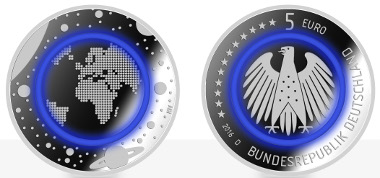by Ursula Kampmann
translated by Annika Backe
May 7, 2015 – The narrow blue ring that separates the map of the earth on the center from the universe on the surrounding ring on the new German commemorative coin “Planet Erde” (“Planet Earth”) is not made of metal but of a polymer. This polymer is a little sensation within minting technology. It has been developed by a team that consisted not only of Dr Peter Huber (Director of the State Mints of Baden-Wuerttemberg) and Günther Waadt (Director of the Bavarian State Mint) but also of representatives of the German Central Bank, CPI / European Vending Association and coin blanks producer Saxonia. The team brought in additional know-how from the Leipniz Institute of RWTH Aachen University.
A testimony of innovative minting technology made in Germany: the new German 5 euro commemorative coin with polymer ring. Photo: © State mints of Baden-Wuerttemberg.
The fruit of this interdisciplinary collaboration is a polymer that can be coined and meets all requirements of a coin material: it is both chemically resistant and resistant to heat and cold, UV radiation and water.
This unique polymer is not only beautiful to look at but can be applied as a new security feature. Thanks to this material, the very first coins can now be produced that keep up with banknotes in terms of counterfeit prevention. Hence, the German mints have developed an innovation which mints throughout the world are currently searching for. Improving the coins’ counterfeit prevention is considered a prerequisite for raising the value limit between banknotes and coins. Today, this is what many central banks are aiming for. The reason is quite simple: coins may be more expensive to produce than banknotes but they stay in circulation much longer. A lot of money could be saved, if a banknote like the 5 euro note, for example, was replaced by a 5 euro coin.
This is now within reach even though the first 5 euro coin is a commemorative coin “only”. The Ministry of Finance wants “to capture the interest especially of young target groups for German collector coins”.
Anyhow, this commemorative coin is not just a commemorative coin but a milestone in the development of minting technology.
There is a good chance that the “tri-material coin”, as this innovation is often called, will spread as quickly as the bi-metal coin that has become an integral part of modern coinage.




